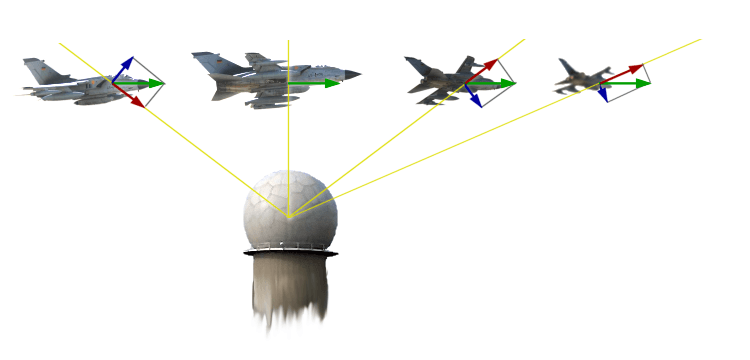Radial Speed

Figure 1: Speed vectors of an airplane into reference to the radar site
Each motion with a given velocity has a direction: It is a vector therefore. In relation to a direction of observation, this motion-vector can be broken down into two components.
- the motion along that radial (either directly toward or away from the observer, called radial speed);
- the motion perpendicular to that radial (called tangential speed).
The diagonal of the rectangle, which is described by these two vectors, is again the real speed of the observed object. The length of the vector expresses the magnitude of the velocity (the longer the arrow, the faster the speed); the direction of the vector is consistent with the direction of movement (the course of the aircraft).
All the radar “sees” is that part of motion along the radial (i.e. along the path of the antenna beam; in Figure this is the red arrow). Mostly this is NOT the real course of the object, but the portion of the object's motion that is moving either directly toward or away from the radar.
The radial speed of an airplane is the part of the speed which acts towards the radar or away from it.
Perpendicular to this is the vector of tangential speed. The tangential speed has an effect on the antenna control of target tracking radars.
If an airplane flies past on a straight course at radar set, it comes to a point, the radial speed is zero here and the tangential speed is equal for the true speed of the airplane. The Doppler- frequency only occurs at a presence of radial speed. If this radial speed is zero, then the radar cannot distinguish this plane from fixed clutter.
At further straight ahead course the vector of the radial speed shows to the radar unit away, it is a negative speed. A negative Doppler-frequency also arises here but this negative sign hasn't got an effect here. It is exactly as large as the positive Doppler-frequency. (Because it is the difference between the received signal and the transmitted signal, this one Doppler-frequency has got a by 180° revolved phase relationship only.)
Well, if an airplane flies around the radar unit in a circle course, then the radial speed is permanently zero. No Doppler-frequency arises and the airplane is calculated by the MTI filter as a ground clutter and this target isn't shown on the scopes.

